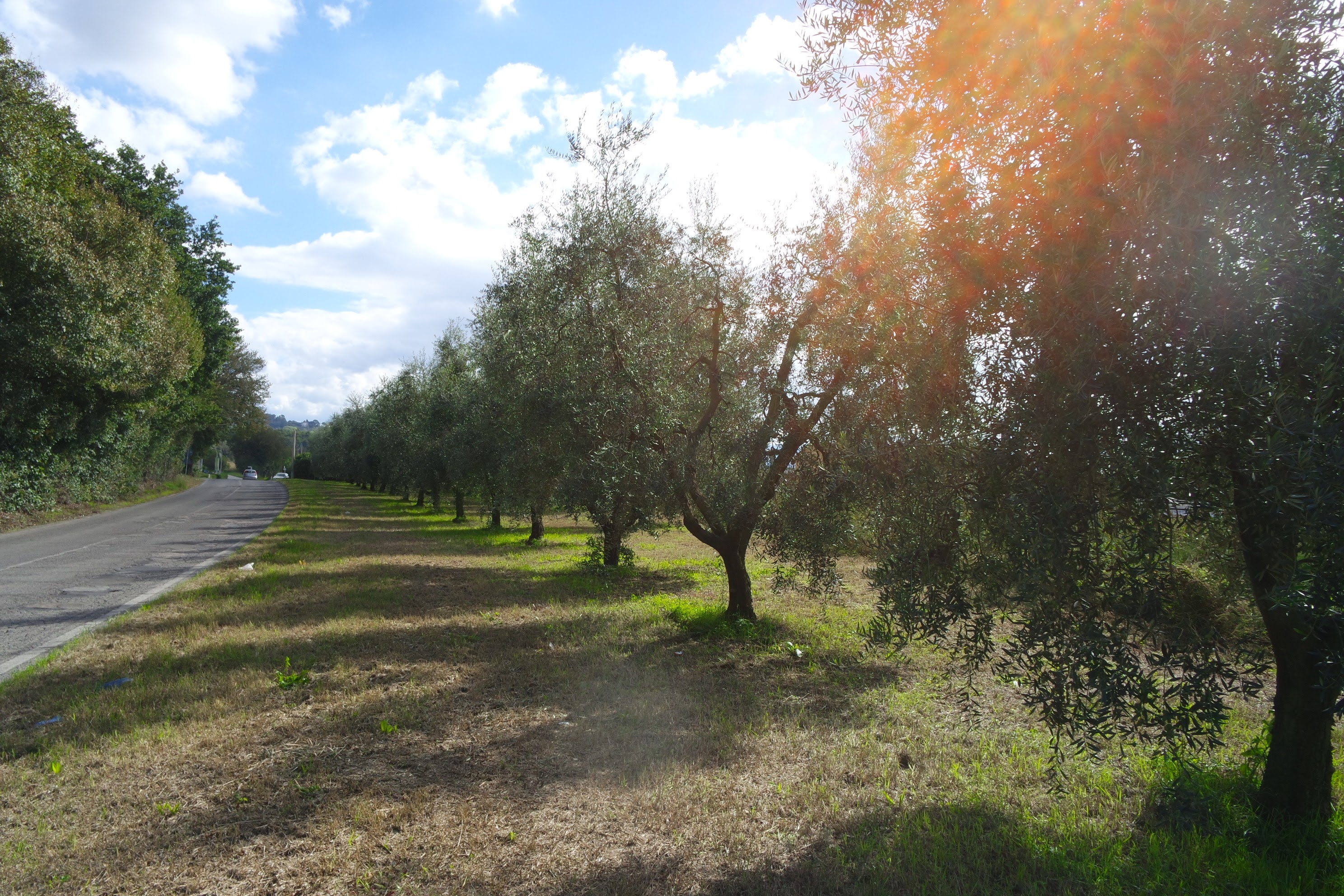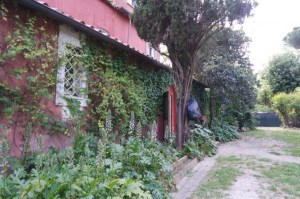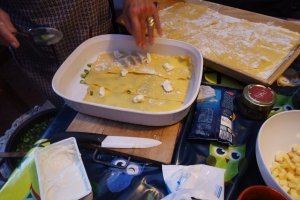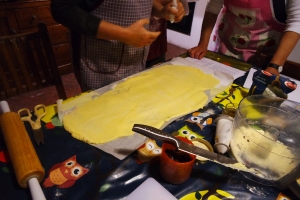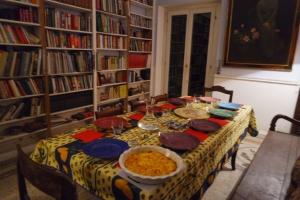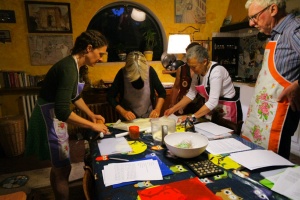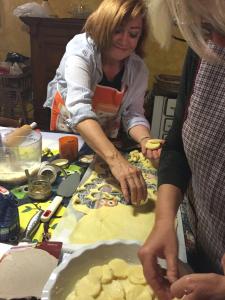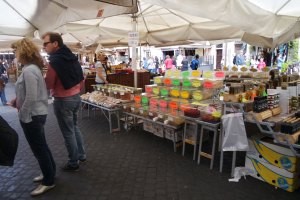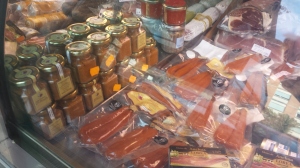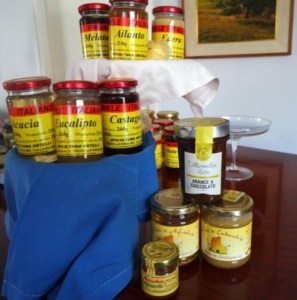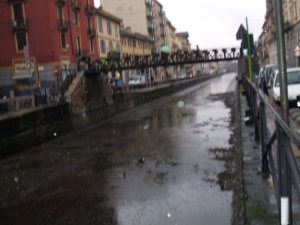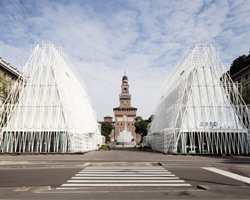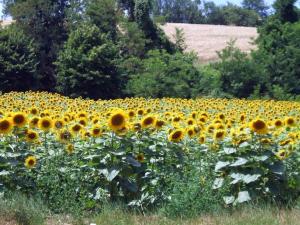Italy
Spring into Italy
Although it’s been a long time since I’ve made a blog entry, I have been visiting Italy twice a year as usual. This year though, I was certain that I would not be able to make my usual spring trip, but fortune smiled on me and while it will be a fleeting visit, it is always a joy for me to spend any time in Italy. Springtime there is especially exciting – the weather is usually great, the crowds slim and the traffic less than normal with holidays taking lots of local people to the countryside. I have so many friendships there now, it is like returning home to make even a short visit.

I was prepared to have to wait until October to return since I am out of just about everything I bring back, it is very lucky to be able to squeeze in a trip. I will make a trip to Farfa to get additional extra virgin olive oil from the frantoio (mill). One of the primary reasons for my consideration of any product is to be completely certain of the quality, freshness and reliability and that is why I personally work with each purveyor. I have total confidence in anyone I work with. I can pass on to you my assurance I work only with the best and highest quality goods.
I hope there will be honey from Sardegna coming back with me on this trip too. The quality, health benefits and varieties of Stefano’s honey keeps people waiting for my return. My husband won’t use anything but his soap (honey, and propoli) and everyone who uses it seems to be addicted to it.
Visiting Mauro Berardi is always a highlight in my travels. Mauro is so kind and helpful as is Marco (his son) and Maurizio as well as all the guys working for him. Most have been there for many years. Mauro loves to tell anyone around who will listen that I have been coming to see him for almost 20 years. The mixes he concocts are deservedly ‘world famous’. The potency of his mixes is so long lasting I can only attribute it to the quality of the individual herbs and spices and that they hand mix all the mixtures. You will never have to worry about any foreign materials in his spices or that they are old and stale. Mauro is always certain that I get the best help and makes suggestions about what I should include. Marizio says the Mauro’s Mix is his best seller, but I usually find myself out of the Campo dei Fiori mix sooner. I am always surprised to have people from all over the world find me on the internet because they are looking to replace Mauro’s mixes.

This spring is twenty years that I have been traveling to Italy. In that time, my husband and I have lived there for a over two years, and traveled to various parts of the country every year. If you haven’t personally experienced life in Italy, I highly recommend it. Life there, like everywhere has changed in the last years, but the pace is still significantly calmer and easier than my normal life. And, no matter which area I visit, I am constantly amazed by the beauty of the land and the kindness of the people. I am so thrilled to be able to introduce more people to the unique qualitites of Italy.

It is my hope that I will be able to continue these journeys for many years to come – there is still much of the country I have not yet seen. If you want to join my mailing list, just send an email with your information and I will happily add you to my list.

Italy Revisited — TV Game Shows
I am currently beginning to pack to return to California. Besides having to find creative ways to get as much back with me as possible without triggering the dreaded third suitcase cost of $240, I have been watching a little local tv.
I have never written about Italian tv because it really is something you need to see for yourself. It is a little hard to explain in any language. I have just been watching Stasera Tutto è Possibile (tonight everything is possible). Now I am the first to admit my Italian leaves much to be desired, especially with long conversations or talk shows, where it is normal for at least three people to be talking at the same time. And over the years I have watched many of these competition type shows, usually with a confused look on my face and my Italian dictionary in hand. There is one where if you lose you are dropped through the floor if you lose (caduta libera – free fall ; one where they spend hours imitating famous singers and are made to look as much like them as possible.


I am not kidding about hours, that program is three hours long. I have seen Elvis, Amy Winehouse, David Bowie and numerous famous Italian singers I am totally unfamiliar with. And listened to the panel critique the contestants ability to mimic not just sound, but looks, style and mannerisms of more famous folk.

Introductions to these varied people

On Stasera Tutto è Possibile, I have no idea what the point is, but they take this motley group and have them sing along with familiar music, like Abba or The Village People. Then they take the away the recorded music and you hear what they actually sound like, which is pretty awful since they don’t know the words or have much in the way of voices. Then by twos they pair off for segui le labiale (sort of read my lips) where one has headphones and tries to figure out what the other is saying. Following this they have sketch games with angled stages and weird(er) costumes. Did I mention you really have to experience it yourself. It is unlike anything on American tv. Although Stasera is 2 hours long I admit by the time they got to the sack races I gave up. It is not the first time either. It is fascinating but I have my limits.


I highly recommend on your next trip to Italy forget whether you completely understand the language and tune in to the uniquely Italian spectacle of game shows.
Artistry in Olive Wood
As often happens a client is the catalyst for new discoveries. This time a client requested olive wood utensils. Having seen many I assumed it would be a quick easy request. As usual, it became something much more. While there are obviously thousands upon thousands of olive trees in Italy, there are not so many available to make olive wood good from. And, while there are commercially made spoons, cutting boards and rolling pins, there are not so many crafted bowls, boards and utensils (that are actually made in Italy).
With the internet it seems easy to find online anything you want. However, like many products, there is often a large difference between the lovely photos and catalogs you find and the quality of the finished pieces. And, the location of manufacturing can be far from where olive trees are grown.
Olives have been cultivated throughout the Mediterranean throughout history. The Romans cultivated olives throughout Italy and olive oil became so valuable they even used it as collected taxes. Ancient olive wood is beautiful and a real sustainable source. As I have mentioned in earlier posts, olives produce for hundreds of years, but eventually they stop producing and are classed as ancient. Usually it is this wood that is gathered and used for crafting the larger pieces of olive wood you see. The large cutting or carving boards, the table tops or large salad bowls. Every tree has its own unique pattern in the grain. You will never see two pieces created of olive wood that look exactly the same.
Olive wood is very hard, strong, durable and has natural anti-bacterial properties which make it ideal for production of items used for food. If cared for properly, olive wood items will last hundreds of years. So an ancient piece of wood becomes an antique long after it is harvested. Olive wood bowls, and utensils of the highest craftsmanship are not as ubiquitous as you might think given how many trees there are here.
Because the olives are a most important crop healthy trees are never felled for use of the wood. The limited availability is part of the reason for the high cost of quality olive wood articles. Although there are artisans in almost every region with high olive oil production, there are not as many craftsmen who work with olive wood. In Tuscany, I understand there are only a handful of artisans who work with olive wood. And, they tend to specialize in the types of pieces they like to make. There is one craftsman in a small town near Sienna that makes only small to large pots with lids, another near Florence that works only bowls. It seems that each artisan has their specialty. That is why I tried to find someone who has worked with these artists and could inform me how to determine the best pieces.
Luckily I found Ricardo Amoruso. He is from Tuscany and has resources throughout the region for artisans in a number of categories (his wife is a ceramicist) including the few who specialize in olive wood. Ricardo explained to me that there is always a shortage of olive wood. If the spring weather is below normal for too many days I believe he said 15) in a row the tree can be damaged and not just lose the crop of olives, the tree can be damaged beyond survival, but the wood also can be unusable from the stress of the cold. He explained that there are numerous makers of kitchen utensils because those do not require the whole tree to be used. In spring when they must prune the branches, they are collected and many are thick enough to be able to form spoons, spatulas and rolling pins. They are the most affordable of pieces in olive wood.
Once I saw some of the fine works he handles I knew that this quality was superiorto most of the other pieces I have seen. The prices will always be high so it is important to get the best quality wood that is formed by the best artisans.
His advice on how to make 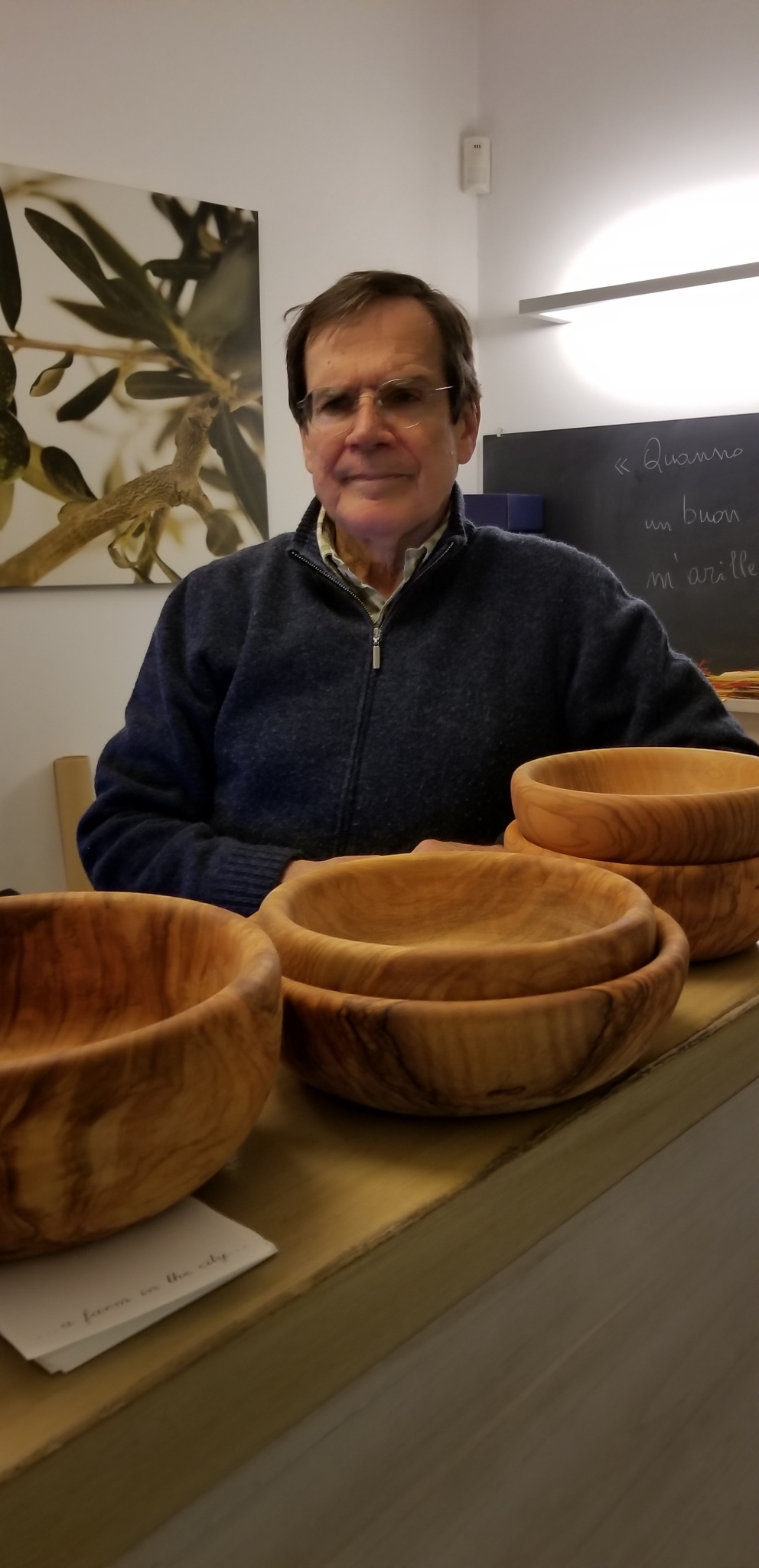 your wood pieces last forever… Do not soak them, or put in a dishwasher. Use only water to clean them. About once every month or so, brush or wipe on a light oil like coconut or sunflower oil and let it sit on some newsapers several hours or overnight. Afterward wipe any left oil with a paper towel.It is important to keep the wood from over drying. This prevents cracking or warping.
your wood pieces last forever… Do not soak them, or put in a dishwasher. Use only water to clean them. About once every month or so, brush or wipe on a light oil like coconut or sunflower oil and let it sit on some newsapers several hours or overnight. Afterward wipe any left oil with a paper towel.It is important to keep the wood from over drying. This prevents cracking or warping.
There are some really spectacular pieces that I am now sure I must have. The bowl below is from the works I purchased for another client.
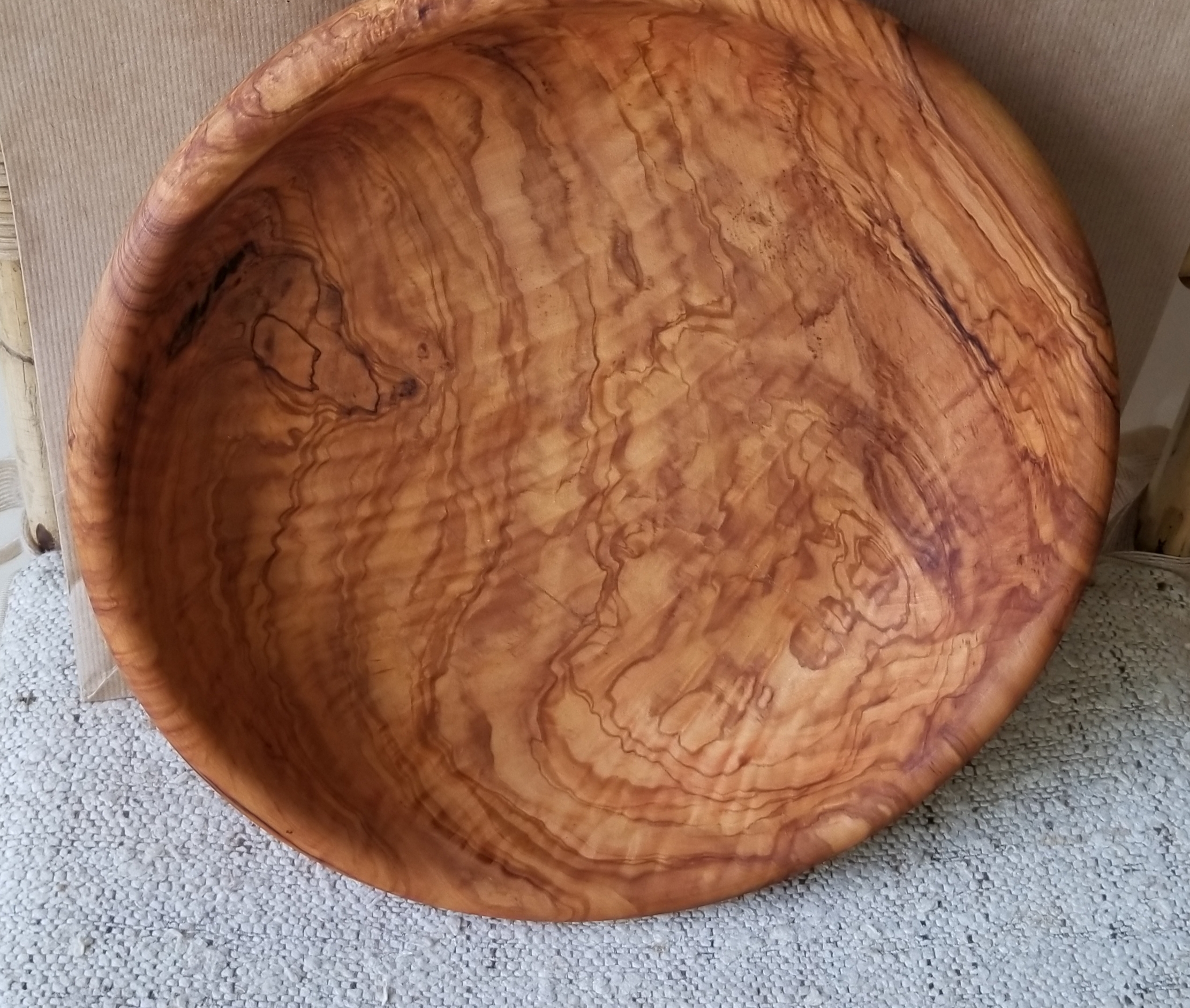
This totally unique flat salad bowl is so stunning I start to drool every time I look at it.
Every trip to Italy introduces me to new places, people and products. It seems a never-ending journey. I have introduced my Sardinia honey source to olio nuovo from Farfa, I have been able to learn about the different grades of cashmere from my scarf vendor in Florence (who uses only Italian materials and workers and produces all she sells right outside of Florence). There are so many fine olive oils available from every region but my clients are spoiled by the consistently fabulous taste of Il Saporito’s olive oil from Farfa.
It is always a challenge to get everything done in the short time I have in Italy (a month is hardly enough time to get your breathing slowed down). And, I always end the trip with my stop at Campo dei Fiori to fill up on the “Spezie Famose nel Mondo” and meet up with Mauro Berardi for his amazing spice mixes that have people all over the world addicted.
If you are not already on my mailing list, just send your email to: expresslyitalian@aol.com and I will add you to my product availability lists.
There is never enough time here, never enough space to bring all I would like and always too much weight. But I love it and hope to continue to introduce products and people from Italy to as many as I can.
Fascinating Olive Oil Pt. 2
I realize it has taken far too long to return to finish the Part 2 information on olive oil, but there have been good reasons. Mostly my traveling back from Italy (bringing along Mauro Berardi’s spices, porcini and all that wonderful Olio Nuovo from Farfa). Then the holidays seem to move in more quickly every year. Or, perhaps it is that I am slowing down somewhat? Nope, that cannot be.
Looking back, it seems unbelievable that I am renewing my EU passport already. While my husband and I managed to spend time in Italy (He mentored young film technicians for Technicolor Rome years ago) before we decided to move there for a couple years on his retirement. After our return it was just too painful to think about not being able to frequently return to Italy (and especially visiting all our friends there), so Expressly Italian was born. While I regret not beginning Expressly Italian’s journey much earlier, my life as an art dealer/ consultant was fulfilling and good preparation for Expressly Italian.

Our View in Belevedere di Riaino
While in Italy we were living outside Rome (about 9 miles north of the center) in the country and made great efforts to see as much of the country as we could. We traveled mostly throughout Tuscany and Umbria and I asked questions always. I shopped every street market in every village because I was fascinated to find how different each was in personality as well as goods. I learned to ask lots of questions even when you think you understand what you are being told. There is not an Italian who is not very happy to have a conversation about food at any time, and if you express any interest they will tell you how their mother prepared their favorite dish, which week is the best to buy whatever product is in season and who is best vendor to buy from.
Living in Lazio I had the chance to watch the seasons change with pruning, cleaning, harvesting and of course, tasting. Tasting is an art. To properly taste olive oil (which many of the frantoio insist you do); first you put a little in the bottom of the glass (the glass is blue so you don’t get swayed by the color the oil, which doesn’t really indicate quality, but more about the variety of olives used). You hold the glass in your palm (to warm it a little and bring out the flavor more), while covering it with the other hand. Hold it and swirl it for a moment or two. This traps the aroma in the glass. The aroma is a very important part of the oil. Now take a good whiff. Do you smell grass, artichokes, berries, cinnamon or olives? The word “fruity” in the context of olive oil can refer to vegetable notes, like green olive fruit, as well as ripe fruit notes. So think of artichokes, grass and herbs as “fruit” when you taste olive oil. I still haven’t found those little blueglasses they officially use in the tastings, but one day I will. 
Now, take a sip of the oil (a decent size sip). You want enough to swirl around your mouth. Think of the way they taste wine. It’s the same. Suck air through the oil to coax more aromas out of it, and then—this is important—close your mouth and breathe out through your nose. This “retronasal” perception will give you a whole bunch of other flavor notes. Retronasal perception is possible because your mouth connects to your nose in the back. Now swallow some, or all of the oil. Think about the after-taste, the pungency of the oil as it goes down your throat. This peppery sensation is what gives great olive oil it’s little after-kick. It’s a pretty addictive impact that can be quite quiet or enough to make you cough. Everyone has their own preferences.
After you’ve done all this, then you should taste the oil with food. Usually just a piece of bread is enough to tell you if this oil is for you. Or potatoes, some mild food that will complement the oil, but still allow you to experience it. So, now you know the ins and outs of tasting and can taste oil with any aficionado with confidence.
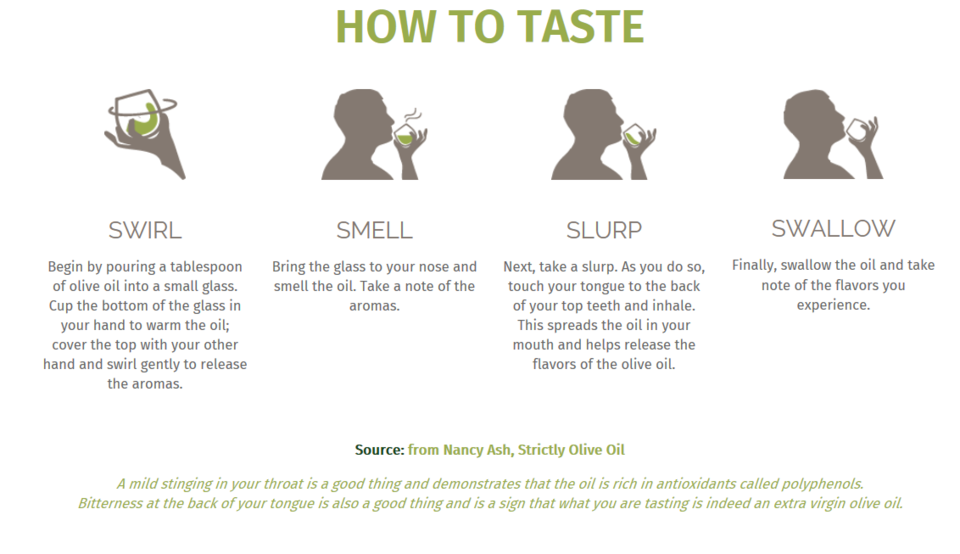
The Sabine hills are about 50 minutes from Rome, and have been producing olive oil for more than 2,500 years. In fact, in Fara Sabina there is a tree called Ulivone Canneto which has been carbon dated to more than 2,000 years old that still produces enough olives to make about 150 kilo of olive oil a year today! This tree made olive oil for the Romans, to Byzantines and modern-day Italians.
An archaeological discovery of the small flask of Poggio Sommavilla traced back to the seventh century BC is preserved in the Museum of Fine Arts in Boston and is the oldest example of writings from pre-Roman times. It is a testimony of the olive culture of this area because in it are the remains of olive oil.
Claudius Galen (129 AD – 216 AD), the father of modern pharmacopoeia, called oil of Sabina “the world’s best known.” And, although Sabina oil is not as universally known today, it is revered by those who have tasted it and experienced its quality.
Sabina is slightly cooler than Tuscany and the hills make it ideal for cultivation of olives. The trees here are some of the largest in Europe and the distinct delicate flavor may be created by the warm winds whipping in directly from the south. There are various strains including Carboncella, Pendolfino, Moraiolo and Rosciola. All are a golden yellow/green and harvested just before turning brown.
Sabina has a consortium of small growers and cooperatives, but my personal preference and practice is to purchase the oil directly from the frantoio of the grower. Rosario presses his own olives from his own groves. He also contributes to the consortium, but I love knowing exactly what I am getting and feeling like I can watch the olives be delivered and watch them be pressed and put into the lattine (tins). It is really exciting and moves really quickly. Sabina DOP is available in many places, but I love knowing exactly how and when the oil is processed and how it is handled. The drive to Farfa is beautiful and serene, although I have to admit I always seem to get lost in the hills on the way there. I am confident that what I offer is as fresh, and high in antioxidants and flavor as possible.
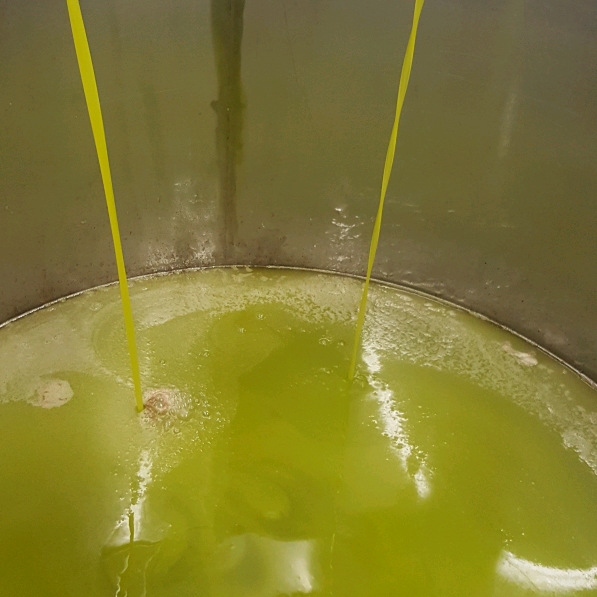
Some of the characteristics of Sabina DOP oil are: Color: yellow gold with nuances of green, Perfume: fruity, notes of fresh herbs and artichoke; Flavor: velvety, aromatic, peppery finish.
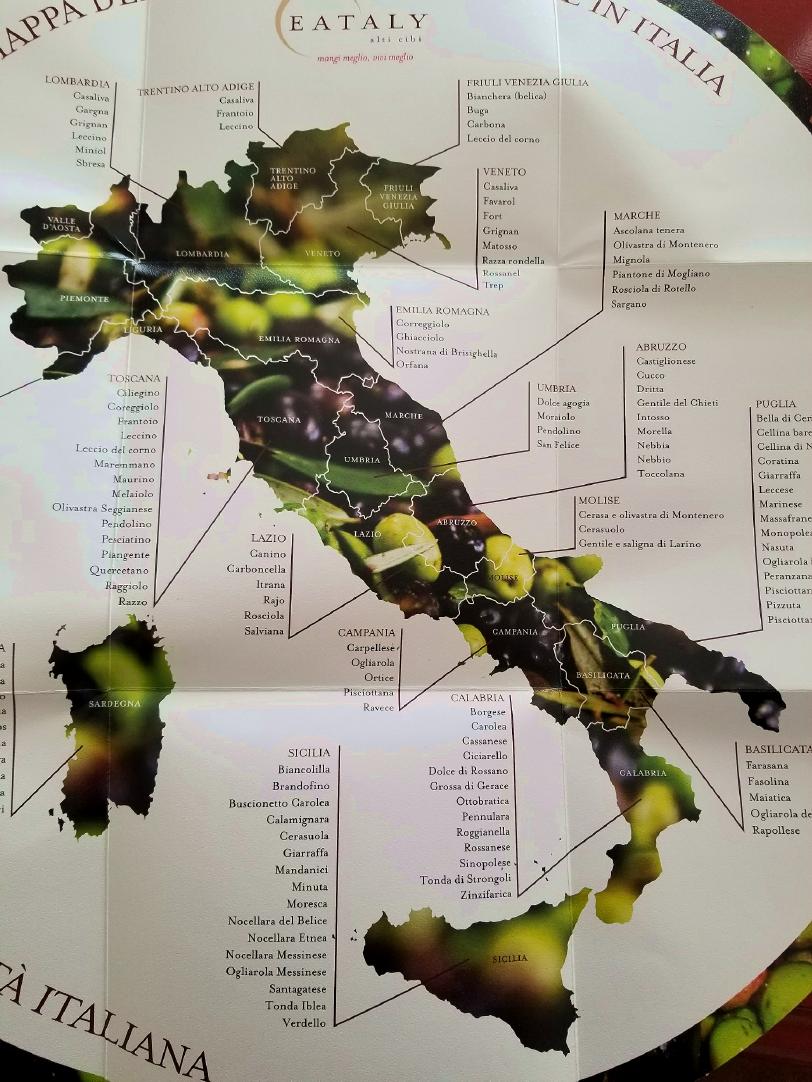
This map is from Eataly.
Each region, even village has different types of olives grown, so the oils are different. In Italy there are 350 different cultivars of olives grown. When you travel in Italy try to taste as many types as you can to give you an idea of which varieties you prefer which may give you an idea of what oils you might like. And, taste oils as often as possible. During harvest times there are often tastings available as well as sagre (festivals) for olive oils which are wonderful opportunities to try different oils.
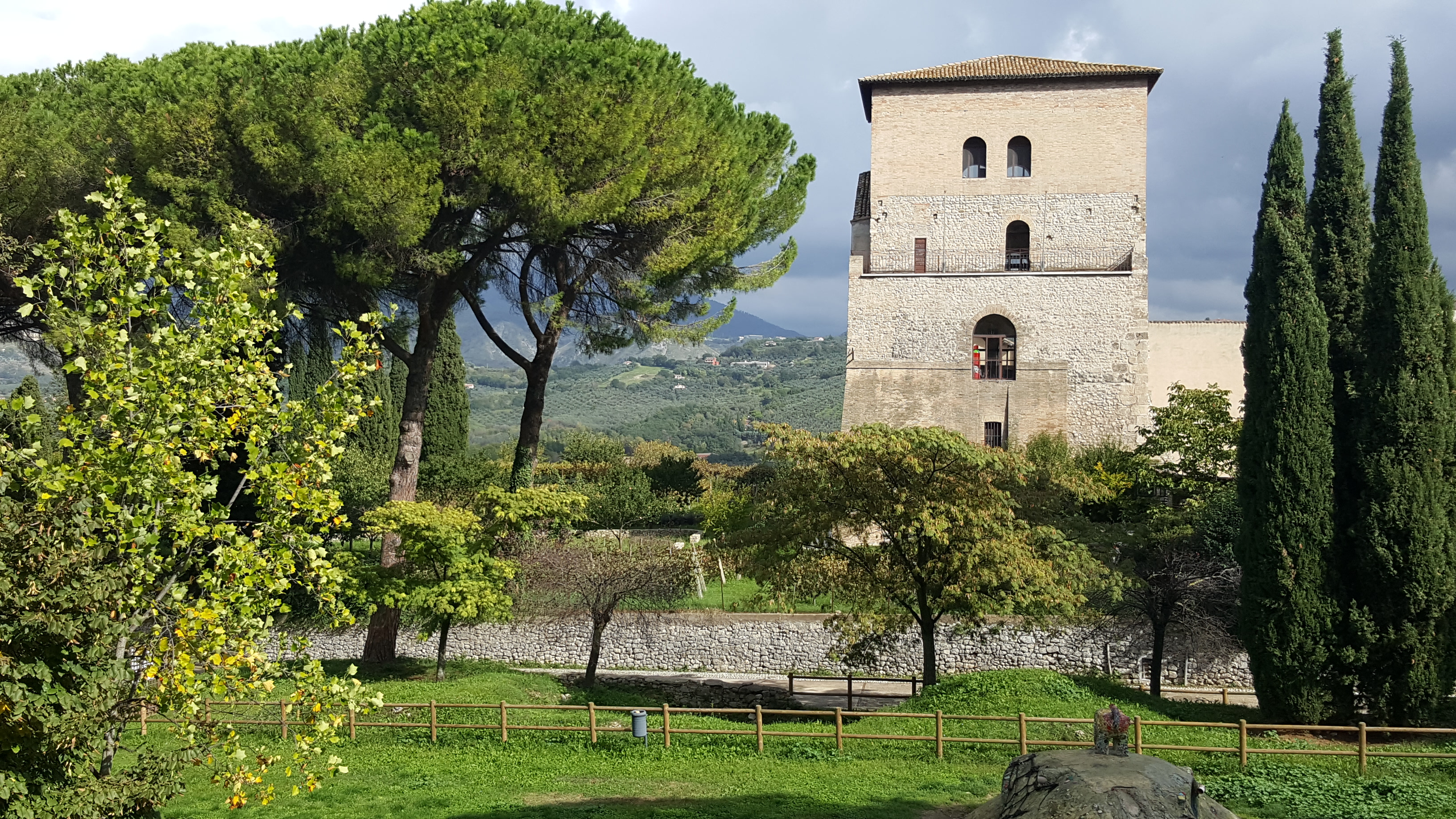
I hope this explains a little more of my fascination with Italian olive oils, and Sabina olive oil in particular. It is so full of antioxidants, great taste and bright flavor, add a little zip to your life by drizzling it on everything you can.
Eating well without being in Italy
All the New Year’s resolutions are in place. Now to implement them. There is a world of difference between intent and accomplishment isn’t there? Oñe of my personal goals is to become an even more aware eater this year. That means not just thinking before stuffing a biscotti in my mouth, but to question ingredients even more.
Frankly, it is pretty disheartening to realize how compromised our food system is. Price is no guarantee of quality. Reputable stores do not assure you products are really as advertised. It has become a major job and time eater just to grocery shop. And it is not all that much better in Italy these days. So what do we do?

Keeping it simple helps a little. Eat mostly fresh foods, the closer I can stay to traditional Italian cooking, especially cucina povera, (cooking of the poor) the better. It is not difficult to find good pasta in the U.S. Look for good quality, especially bronze cut pastas. Always check the dates. It should be about year ahead for dried pasta. I find that Berilla is one of the best selling dried pastas in Italy. Good enough for me. The artisanal pastas are great ( I often see them at TJ Maxx or World Market), and the different shapes are always fun, but I do not find them necessary for normal cooking. (And, again, check dates. Sometimes those are the oldest pastas).
With a well stocked pantry (in an upcoming post I will give a serious list to help) you can always cook a great, healthy dinner in less than 30 minutes. Winter weather always makes me feel like Ribollita – the Tuscan bread soup. It makes a huge pot that tastes better every day. And, it makes me feel healthy.
Here’s a recipe I adapted to use Campo dei Fiori Spice Mix, and you can use Mauro’s Mix as well.
Ribollita – Tuscan Bread Soup
This is a traditional Tuscan soup that stays good till you finish it. Days or even a week and it holds up perfectly. Supposedly it should be thick enough for a spoon to stand straight if you put it in the pot. I adjusted the recipe to use Campo dei Fiori Spice Mix or Mauro’s Mix to ‘kick’ up the flavor a little more.
1 onion finely chopped
1 leek sliced
2 quarts chicken broth
1 head kale or nappa cabbage or regular cabbage
2 stalks celery sliced
1/2 cup parsley leaves chopped
2 carrots sliced
2 zucchini sliced
1 small bunch basil leaves torn
1 10-ounce can cannellini beans or kidney or borlotti
2 tablespoons tomato paste
2 tsp Campo dei Fiori Spice Mix (to taste – you might start out with only 1 tsp and adjust)
1 teaspoon salt preferably sea salt
1/2 cup olive oil extra virgin
1/2 pound stale Italian bread
Freshly grated Parmesan cheese
Sautè onion and leek in 1/4 cup olive oil several minutes until translucent.
Add a cup of chicken broth and bring to a simmer. Add the kale, other vegetables, and basil to the onions and broth.
Cook for 20 min., covered. Add the beans and the rest of the broth. Add tomato paste, oregano and season to taste with salt and pepper.
Cook for 90 minutes. At this point it should not be thick. It is best to let the soup rest a day in the refrigerator. It does deepen the flavor a lot.
Put the soup in a pot and layer the soup with thin slices of day old bread. It doesn’t make any difference how stale, or whether it’s torn or sliced, or what kind (although a good Italian or French is best). Heat while stirring until the bread breaks up and thickens the soup. You can add more broth or water if needed (but I haven’t ever needed any).
When the soup is done, turn off the heat and stir in 1/4 cup olive oil. Taste for salt. Serve with fresh grated cheese on top. It just gets better and better. This is the typical cucina povera of Italy.

It is unfortunate that we have to spend so much energy to decide what is good for us, but it is worth the time to protect your health.
I hate to continue to nag about olive oil, but it seems every week there is more evidence that so much of what is available is either mislabeled, overpriced or not even real olive oil. If you did not see the expose on “CBS 60 Minutes” recently, look for the video online. I know that much of the oils imported are not good, but I really didn’t think about the extent of mafia involvement. I do know they send containers of oil to the U.S. which is then bottled here. It can have sat waiting for customs in the heat for a month, which destroys most of the value of the extra virgin oil, but they still label and sell it as premium oil. I used to hear that Europeans did not send their best oils because Americans did not know the difference. Unfortunately, most Americans have still not tasted good olive oil.
A friend forwarded a newsletter from Brenda Watson, an author and expert on digestive health care. She had lists of the ‘good’ and ‘bad’ olives oil. This was apparently originally from a Consumer Reports study. I won’t drag on about the ‘good’ list. The bottom line is always, read the label. It should have the per cent of acid in the oil, the date of harvest and best use by. And, it is important to know exactly where it comes from. In Italy, the city is always on the label, usually the type of olives and to qualify as extra virgin the acidity level must be below 0.8%. Don’t pay for any extra virgin not labeled as such.
The bad oils are a real disappointment. Those are most of the best known oils available in our stores. Do not think you are getting the health benefits of olive oil if you are using these:
Bertolli, Carapelli, Colavita, Star, Pompeian, Filippo Berio, Mazzola, Mezzetta, Newman’s Own, Safeway and some of the Whole Foods oils (other than their 365).
I bring back only olive oil that I can find at the frantoio (olive mill), where they follow the very stringent laws of Italy to produce their extra virgin oil. As often as possible I bring the olio nuovo (which is the first pressing of the beginning of the harvest). It is rarely sold in stores. And, the on-line sales run into the same problems of temperature variations and delays. And, their prices are higher than mine. I still have this season’s harvest oils so if you want to experience the true liquid gold of Italian Olive oil, get in touch with me at expresslyitalian@aol.com, or leave a note here.
In addition to olive oil, I still have honey from Sardinia and dried Porcini from my last trip. I am constantly searching out the finest, freshest products. My last stop on every trip is Campo dei Fiori in Rome to meet with Mauro Berardi. Mauro is generous with his time and they always pack me the freshest spice mixes. If you are out, get in touch. I usually have on hand his primary mixes. I can always shop for you when I am there for some of the more unusual products from him, just let me know what you want and I’ll get it for you.
I know that having to spend so much energy reading labels is a drag. I am finding that it makes such a difference in the flavor of what you cook though, it is well worth the extra time. Be healthy! Eat Italian.
Shopping Italy in the Spring
I have been in Italy a week or so. It’s not like traveling anymore. It is more like visiting my home. While I live in Los Angeles, my heart and mind often wanders to Italy. There are just so many beautiful an interesting places to visit throughout the country there seems never enough time.
This shopping trip is a little less hectic than the fall trip. I will make my visits to Mauro Berardi in Campo dei Fiori. It seems his self proclaimed Famous Spices of the World is a true statement. Almost every week I get an email request for information on how to acquire his spice mixes. They are amazing. He sells seemingly vast quantities of spices, but they are all still mixed by hand in his offices nearby the campo. Lately there are a couple of other vendors using “Campo dei Fiori Spice Mix” on their spices blends, but they are nothing like his mix. So, he is now referring to his mix as Maruro Berardi’s Pasta Mix. I am not certain this is a great change since many people will think that is all the spices are good for is pasta. His mix is universal not only in appeal, but in the ways it can be used. I rarely make eggs without a dash of this mix, or soups, stews, marinades or dry rubs, even in salads. In fact, I use it constantly since it can be cooked or used as is. So, if you are looking for Mauro, he is in the same place as always, but the mix name has changed.
Now that we are straight on that, I can tell you how exciting this trip really is. It is wonderful to be buying items for my clients and know that they are not paying 30% more than the price seems. I love that the dollar has been staying around $1.10 to a euro. I hope it keeps there for awhile (as I am sure all my clients do as well).
I have been busy shopping and have purchased some pre-ordered products for clients, including the spices. Also some of the amazing flavorful preserves that have so much more flavor than the U.S. varieties seem to. Maybe it is they use so much less sugar that you can taste the fruit?
I am off to Milan early next week. I look forward to meeting up with Stefano to pick up honey. I learn something new every time I meet with him. He has been worried I would not arrive soon enough since the current harvest product is almost gone and it will be awhile until the next harvest. Sardegna has one of the only totally pollution free environments left in the world. No insecticides, no soil additives, no smog. It is not wonder that Sardegna produces honey with thhe highest levels of antioxidants. He sells much of his honey for the health benefits, but I love the taste of almost all of them. And, my clients love all his products, the propolis, his beauty cream (which has only bee pollen, bees wax, olive oil and lemon oils) and his “Bomba” and “Rispero” for well being and breathing problems.
In addition to the honey from Sardegna this trip I am bringing bottarga as well. I have been bringing Tuscan bottarga from the Maremma, but thought I’d try the Sardinian bottarga which is supposed to be fabulous. It should be — it is quite expensive. I think I will buy a whole piece and divide it for my clients so it will only be pricey.
I cannot wait to see the scarves for spring and summer that I buy there as well. I do not bring many back, but I seem to have requests for them every trip.
If you are not on my mailing list, please get on it! Send me your name and address in an email to: ExpresslyItalian@gmail.com. I’ll make sure you are kept informed about my offerings.
I have another dinner with friends tonight, It is reassuring to know you cannot have a bad meal in Italy, Well, I guess you can, if you frequent tourist restaurants. So, do not do that.
If you are planning trip to Italy and would like to connect with some cooking classes or garden tours, I have some suggestions for the Rome area and I would be happy to help. And do not forget Expo Milan – from May 2 through October.
Expo Milano 2015 is close – Make a trip to see a World’s Fair
This is an exciting time – spring is bound to be hitting the whole country soon, Easter is almost here and the 2015 Expo Milano is almost ready to open! This Universal Exposition which takes place every five years, each time in a different country. This year, from May 1 to October 31, the 272 acres the Expo is on will be available for the world to enjoy.
Expo 2015 is themed “Feeding the Planet, Energy for Life” with a focus on sustainability and innovation. All 140 participating countries will showcase their unique cultural and culinary traditions, within self-built lots, to the 20 million expected visitors from around the globe. Whew! That’s a lot of people, but it is a great amount of space to cover. And that’s without considering that there is also all of Milan to see. And, the Milanese have so many planned events in the city to entertain all the visitors it is a cannot miss trip.
The layout of the Expo grounds are inspired by a Roman city of ancient times. The city has allocated over 60 pavilions in this ‘village’ to participating countries which will line either side of the long central division. Italy’s exhibition area intersects to form a global meeting place called Piazza Italia. The space has also provisioned for event areas like the open-air theatre, Lake Arena and children’s park, as well as clusters for other official industry participants.
There is even a Google interactive map you can watch what is happening in real time. Check it out. Google Earth – Expo 2015 the EU pavillion – interactive map http://europa.eu/expo2015/node/115
I did not see that the U.S. Pavilion has a google map dedicated to it, but it is moving along quickly to completion. The US Pavilion – Designed by award-winning architect, James Biber, the USA Pavilion pays homage to our rich agricultural history with an open design delimited by a large vertical farm that will be harvested daily. An homage to the barn is reflected in the design of the pavilion.
Located in central Milan for the duration of the Expo, the James Beard American Restaurant will showcase American cuisine, ingredients, and beverages with a rotating roster of American culinary talent. Thanksgiving dinner will be served every Thursday and Jazz or Gospel brunch every Sunday.
Leading up to Expo Milano and throughout the six months of the fair, the USA Pavilion will be programming daily activities, on the topics encompassed by our theme American Food 2.0: United to Feed the Planet. From conferences on global food security to cooking demonstrations, panels on technological innovation in the food system to conversations with top farmers and chefs, we’ll explore various aspects of food, food culture, and the future of our food system. Topics will cover a broad and diverse spectrum, including how to manage water resources, the importance of food labeling, healthy school lunch, traditional American cooking, and how can we create a burger that’s better for our health and better for our environment.
If you are planning on travel in Europe this year, be sure to put this on your itinerary. It’s really a unique experience that cannot be repeated. Being Milan, the city has really gone all out to provide an Expo experience throughout the entire city while the fair is happening. There are art events, fashion events, tours, and so much has been already completed to make the entire city ready for the spotlight.
Among the most important events already on schedule, Milan will feature the biggest exhibition ever organized in Italy of Leonardo da Vinci with works of the Renaissance icon borrowed from Italian and international museums.
Another exhibition will be dedicated to Giotto, the Florentine painter who revolutionized the depiction of figure in the 1300s, with three of his masterpieces on loan.
International artists from avant-garde to today will represent the theme of motherhood that most of all embodies the idea of nutrition, central theme of Expo Milano 2015, in an exhibition, “The Great Mother,” gathering over 80 works of the 20th century.
Music will be central, Del Corno added, with extraordinary programs at Teatro alla Scala, that for the first time will stay open in August with a total of 140 spectacles during the six-month expo, and Piccolo Teatro, which will perform in many languages including English, Chinese and Greek.
“Milan will be a stage open to everybody,” the assessor went on saying. Duomo Square, in the heart of Milan, will host classic and pop concerts free of charge, while public spaces in the city from parks to trams will be animated by countless music performances, book fairs, street markets and thematic events including many dedicated to water.
The architecture of the fair is wildly impressive. Here’s a photo of the entry gate proposal, I saw in Milan a couple years ago. This is the only structure that will remain after the fair. It’s by Nemesi & Partners and is a smog eating, almost zero energy building. It is exciting and I cannot wait to see this in person.
If I sound excited, I am. I have already purchased tickets for my upcoming trip in April (they have a ‘soft’ opening starting this month), but also for my fall trip, in September.
I’m leaving on my spring buying trip in late March! In addition to touring the Expo Milan, I’ll be shopping for all kinds of goodies to bring my shoppers.
Fresh Sardinian honey and propolis as well as some of his propolis soap and beauty cream is high on my list. Honey from Sardinia is extra special since it is harvesting from one of the few pollutant free environs in the world. No wonder it tastes so good. Stefano has honey from a variety of locations on the island, since there are over 200 species of nectar producing plants, I get everything from Acacia and Ailanto to Malata and even Corbezzolo. From the Maremma I will bring some of their unique items like Colatura di alici da Cetara, and the purest fennel pollen available anywhere and some of the products from the organic small growers in the area like La Parrina and Terra Etrusco in Capalbio and near Il Poderino in Montiano.
And, of course, the important stop at Campo dei Fiori for spices from Mauro Berardi’s Spezie famose nel mondo (world famous spices). Anyone who has visited that market seems to have purchased some of his spice mixes. And, they are not available anywhere else. He does not ship outside of Italy, but he is happy to supply me to bring them home and make them available to everyone. The most popular are the Campo dei Fiori Mix and Mauro’s Pasta Mix. Both of these have the same ingredients, except Mauro’s mix has no salt or pepper. This mix enhances everything it touches. Whether cooked or fresh, it adds a depth of flavor well beyond the ingredients listed. I use it in almost anything I cook from salads (where I sprinkle a small bit on the lettuces) to soups, meat marinades, and any pasta. If you’ve tried it, you are a fan, no doubt.
Every trip brings special requests and new finds. If you are already on my newsletter mailing list, you’ll be kept up-to-date on my trip. If you are not receiving the newsletter, please send me an email and I’ll be happy to add you to the list.
Don’t forget this is a great year to travel to Europe. The euro exchange rate is lower than in many years, currently about 1.10 euro to a dollar. And, Expo Milan is a unique experience never to be repeated.
CARNEVALE – NOT JUST FOR VENICE
If you’ve ever been in Italy before Easter, you know the joys of Carnevale. Although Venice is world renowned for it’s amazing Carnevale parties, costumes and celebrations, but other areas of Italy are also in the spirit of full on celebrating before the deprivations of Lent. The kick off for Carnevale is February 17th, this year. Venice is an exceptional exprience at this time of year, but celebrations are held all over Italy from Venice and Milan down to the villages and towns of Sicily. The celebration of Carnevale is the Italian version of Mardi Gras. of beads.
Originally, Carnevale used the costumes and masks to allow the people to mingle, the rich were not recognized and the poor could parade as if they were equal and no one would know. And, there were plenty of women who chose to dress as men, and vice versa. Today the costumes and masks continue to captivate young and old. And, each area of the country has their own way to celebrate.
In the past few years, Ivrea, which has been celebrating this way since the 1600’s has been getting more attention because part of their celebrations is to throw 400 tons of oranges. Yep, 400 TONS. This is the celebration of the town uprising against the regime in power. It’s very much like our Boston Tea Party, although much messier. Like most Italian events it is accompanied by a parade, a palio (competition) and then a huge feast, and of course, fireworks displays.
 There are many cities throughout the country that have equally unique Carnevale celebrations. In Viterbo, which is just north of Rome., the commune of Ronciglione has become quite well known for their celebration. They have been celebrating for more than a century so there is a well established program. They have a “King of Carnevale” who takes over the town from the mayor and begins the parties. He’s followed by riderless horses running through town. There are days of horse races, parades with floats, parties and confetti thrown. And, of course, lots of food.
There are many cities throughout the country that have equally unique Carnevale celebrations. In Viterbo, which is just north of Rome., the commune of Ronciglione has become quite well known for their celebration. They have been celebrating for more than a century so there is a well established program. They have a “King of Carnevale” who takes over the town from the mayor and begins the parties. He’s followed by riderless horses running through town. There are days of horse races, parades with floats, parties and confetti thrown. And, of course, lots of food.
Then there is Rome. Since about 2010, Rome has re-invented their Carnevale. And, the celebration seems to be growing very quickly. Carnevale is very much for the kids and family in Rome. For them, it is a combination Halloween and Christmas and they love being in costume. There are many events to entertain the children from the Zoo having special programs, to horse shows and competitions and some racing.
Rome’s Carnevale, it has always been about the horses. The most well-known of Rome’s annual carnival events is the horse-drawn parade taking place along Via del Corso at 16.00 on 17 February. Involving more than 100 horses and carriages, the parade evokes the Berber horse race that was historically the most important event of the Roman Carnival until 1874 when it was abolished by King Victor Emmanuel II due to the death of a spectator. The finale is a really spectacular fireworks display in Piazza del Popolo.
There is always a full program of musical performances when there is a celebration in Rome and certainly there are many of all types of music available this month. Piazza del Popolo and Piazza Navona are both centers filled with children and families watching the street performers, puppet shows and throwing confetti on everyone. It’s great fun.
This year Rome Carnevale celebrates Queen Christina of Sweden on the 360th anniversary of her arrival in Rome, with a number of initiatives organised by the city in collaboration with the Swedish embassy and the Swedish Institute of Classical Studies in Rome. So you can expect many art exibitions and musical programs for this tribute.
Ahhhhh. And the food. Never forget the food. Like most things in Italy, although the sweets may be similar, each region has their own name for them. In Rome, the most popular sweet, and only available during this time is the frappe. Frappe are flat, crisp sweets often covered with powdered sugar. They are also called Frappole, Sfrappole, Flappe in central Italy, Cenci (“tatters”) orDonzelli (“young ladies”) in Tuscany, Crostoli (“crusts”) or Galani in Veneto,Lattughe (“lettuce”) in Romagna, Nastri delle Suore (“ribbons of the nuns”) in Emilia, Bugie (“lies”) in Piemonte, and Gigi in Sicily. I am drooling just thinking about those sweet crunchy treats. But, don’t forget to try the bigne, which are filled with cream, usually yellow, but sometimes you can find a cream of a different flavour; and castagnole are fried balls of dough about the size of a chestnut covered in sugar.
I have a great recipe for castagnole. They are a little like a cake doughnut. You just pop them in your mouth and it is amazing how many you can consume before you even realize it. The sugared balls are very popular, but there are also the gorgeous ones that are done by first dipping them in Alchermes, the blood-red Florentine liqueur, before the sugar coating: the ‘bath’ in the liqueur gives them a look of tiny peaches.
Here’s a recipe so you can try them yourself.
200g flour, preferably ‘00’, about 7/8ths of a cup
40g butter, about 3 Tablespoons
2 eggs
40g sugar, 1/3 cup
8 g baking powder, 2 teaspoons
Grated zest of one lemon
Oil for frying
Granulated sugar
Alchermes (optional)
Directions:
Place the flour, sugar and baking powder together in a large bowl. Create a well and add the butter and eggs and lemon zest. Begin beating the ingredients from the center and slowly incorporate the flour. (This is the same mixing process you use to make pasta!) Mix until all the flour is absorbed and a thick dough is created.
Cover and let rest for 30 minutes. Divide into four parts and roll each part out into a long cord. Cut each cord into chestnut-sized pieces.
Heat the oil for frying. Deep fry the dough until golden. Remove from the oil and place on a tray with paper towels. Let drain for 1 minute.
Quickly place in a bowl with the Alchermes (if using) and roll to lightly soak the balls. Remove from the Alchermes and place in a small paper bag with 1 cup of granulated sugar and shake to cover lightly with sugar. If you do not use the Alchermes, just put them directly into a paper bag with the sugar and coat.
They are best eaten warm, but can also be served at room temperature. I do not know how long they keep, I have never had any left over.
SUMMER 2014 MAY BE ENDING BUT HERE COMES EXCITING FALL!
Well, as August ends, Italians are returning to work from their vacations (vacanze). Most Italians do not travel outside the borders of their country. It may seem that has been happening more often with the poor economy, but honestly, it’s always been that way for most Italians. They love their country. Within it’s borders are almost any type of environment you could want for vacations; mountains, lakes, two seas to explore the beaches of, as well as more art, monuments and historical locations than almost anywhere else in the world. Why would they leave?
I recall my husband talking to a co-worker shortly after our arrival in Rome. He told the guy we were going to Venice and he was very excited. The older man shrugged his shoulders (it takes a couple of years to develop the Roman shrug) and said have a good time. Mike asked if there was anyplace special that we should make an effort to see. The man responded “how would I know, I’ve never been there”. When Mike asked why in 70 years he’d never visited there. His response was “Why?” Everything I want is here in Rome. And, there are quite a few Italians who never venture beyond their province or commune. For us American’s it is hard to fathom that thinking. We love to go whether it’s in the US or abroad. We’re adventurers.
Which brings me to something I’ve been waiting to share with you. Some of the names have been changed to protect this man’s identity. I admit when I first received this accounting I was rolling on the floor laughing. Not only is this entirely possible wherever you travel, but can be expected in some variation on any trip to Italy.
This man, a Californian, decided to take his adult daughters on a trip to Rome. He’d only been there many, many years ago for a short trip and one of them had never been there. The last I saw of him was on the via Veneto where outside his lovely hotel I was giving directions to the next stop on his trip – Tuscany. He’d rented a car, it had GPS, he was confident.
His travel agent had worked out the full itinerary with directions. And, he said he followed the directions exactly. When they arrived it was getting dark, but it appeared the location was not at all as promised. It had all the amenities as promised, BUT. The pool was covered, filled with leaves and had grown green water. The chairs around the pool and tables were plastic and overturned on the lawns. All of them. He was a little concerned that it had an entirely empty parking lot that would hold 60 cars. They found the restaurant was closed and there was not much activity anywhere nearby. His daughters were the ones who realized they were in a hotel with the same name as their reservations, but hours driving time away from where they were that evening. . This after lugging overweight luggage up several flights of stairs (no elevators). Nothing could be done until the next day anyway, but it was not a happy evening.
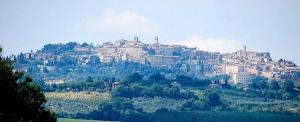
The next mornng they drove to the correct hotel, which was gorgeous. By then, things were a little tense between them since they had lost a whole day of our precious vacation. He said they did spend lots of time investigating Montepulciano, which has become one of his favorite places. A salvaged vacation after all the previous difficulties (yes they also had arrival problems in Rome, tour guide problems there, and more). Then came the last day of the trip.
One of his daughters became quite ill and had to go to the hospital in Florence. The other daughter returned to her home in New York on her scheduled flight. It turned out the hospital was quite helpful and kind. She was only really dehydrated and needed an IV for hours but was fine afterwards.
Of course, they missed their flight back to California though. They were booked on Alitalia, on their last day of their direct service to LA. There were no more direct flight from Rome to LA. (For the record I remain confounded that there is no direct flight from Los Angeles to Rome from late October until March !) They had to leave the hotel in Florence with three overweight bags between the two of them. They still have no idea how they managed it, but they got the train, along with their luggage from Florence to Rome (near the airport for easier access). There were no available flights and he felt Alitalia was unhelpful. It does seem like they could have arranged something with their partner airlines (Delta, Air France, or KLM).
They got rooms at the Best Western near the airport (where few other than travelers speak English) and it’s truly in a barren industrial area. He called on his cell phone every airline he could find (his cell bill was $1,800). His local Vodafone SIM had been used up and where he was there was no Vodafone place and he could not understand the texts he kept receiving from them instructing him what to do.
Alitalia told him he would have to change his reservations through his travel agent because that’s how he made them. (Of course, by this time he’d fired the agent.) The agent was not returning his phone calls.
Finally, he truly panicked and just wanted to get home. There was literally no way to get out for days, unless they would take Air Nigeria to Turkey, then three stops in Germany, an overnight at Amsterdam, then New York and then LA. Even panicked he knew he could not do that. So, like any good American, he “bought” his way out. He spent over $6,000 on airfare to take British Air to London and London to LA. And, of course, that was not for first class flights. But, he had waited several days already and enough is enough. He missed four days of work and the vacation costs were much higher after his vacation was to have ended that it was for the rest of the trip.
Sometimes, it’s just that bad with traveling. Thank goodness it’s not often. And, much funnier when it happens to someone else. He said “Italy was beautiful but he was not ready to laugh about it yet”. Hopefully, enough time has gone by that when he reads this he’ll appreciate the experience a little more.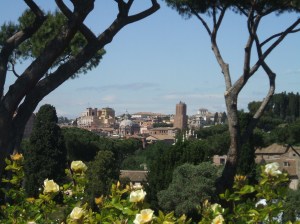
Being prepared is good. Knowing things will go wrong is even more important.
I’m readying for my fall trip – think olio nuovo, fresh olive oil. Honey, and new found products. If you want to receive the newsletter on available products, please email me at: expresslyitalian@aol.com.
If you have any questions about how to use any products or suggestions about what I should try to find, let me know. For sure I will be stopping at Campo dei Fiori for spices from Mauro Berardi and his”famous spices of the world” as well as Umbria and Tuscany for first pressing olive oils, the Maremma for Botarga and a few other specialties. And I’ll also visit Torino for a chocolate festival and stopping to pick up some of that fabulous Sardinian honey and who knows what else. I’m open to any suggestions. Just let me know if you have any special requests. I’ll be happy to do what I can to help.








